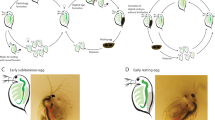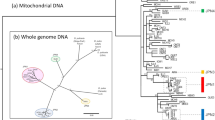Abstract
Ninety populations of Daphnia pulex from sites throughout the UK and Scandinavia were assayed for genetic variation at 11 variable enzyme loci. A latitudinally-related cline in both breeding system and ploidy level was observed. Southern populations (latitudes 52–59°N) comprised only diploid cyclic parthenogens. Northern populations (latitudes 68–71°N) were dominated by polyploid obligate parthenogens and diploid cyclic parthenogens were absent. An assemblage of populations from a site of intermediate latitude (61°N) included both diploid cyclic parthenogens and diploid obligate parthenogens. This cline parallels one previously described from temperate to arctic North America. The obligately parthenogenetic (asexual) clones were generally heterozygous at one or more loci for a common D. pulex allele plus an allele not found in cyclically parthenogenetic (sexual) populations of D. pulex: it is argued that these asexual clones arose polyphyletically following several independent hybridizations between D. pulex and an unrecognized but closely related taxon. Fifteen different asexual clones were detected and 25 of 28 asexual populations were uniclonal: the mean number of asexual clones per population was 1.21.
Similar content being viewed by others
Article PDF
References
Beaton, M J, and Hebert, P D N. 1988. Geographical parthenogenesis and polyploidy in Daphnia pulex Leydig. Am Nat, 132, 837–845.
Beaton, M J, and Hebert, P D N. 1990. Miniature genomes and endopolyploidy in cladoceran crustaceans. Genome, 32, 1048–1053.
Beaton, R A. 1957. Parthenogenesis and Polyploidy in Mammalian Development. Cambridge Monographs in Experimental Biology, no. 7. Cambridge University Press, Cambridge.
Bell, G. 1982. The Masterpiece of Nature: the Evolution and Genetics of Sexuality. Croom Helm, London.
Cavalier-Smith, T. 1978. Nuclear volume control by nucleoskeletal DNA, selection for cell volume and cell growth rate, and the solution of the DNA c-value paradox. Cell Sci, 34, 247–278.
Crease, T J, Stanton, D J, and Hebert, P D N. 1989. Polyphyletic origins of asexuality in Daphnia pulex. II. Mitochondrial DNA variation. Evolution, 43, 1016–1026.
Glesener, R R, and Tilman, D. 1978. Sexuality and the components of environmental uncertainty: clues from geographic parthenogenesis in terrestrial animals. Am Nat, 112, 659–673.
Hebert, P D N, and Beaton, M J. 1989. Methodologies for Allozyme Analysis using Cellulose Acetate Electrophoresis. Helena Labs, Beaumont, Texas.
Hebert, P D N, Beaton, M J, Schwartz, S S, and Stanton, D J. 1989a. Polyphyletic origins of asexuality in Daphnia pulex. I. Breeding system variation and levels of clonal diversity. Evolution, 43, 1004–1015.
Hebert, P D N, Schwartz, S S, and Hrbacek, J. 1989b. Patterns of genotypic diversity in Czechoslovakian Daphnia. Heredity, 62, 207–216.
Hebert, P D N, Schwartz, S S, Ward, R D, and Finston, T L. 1993. Macrogeographic patterns of breeding system diversity in the Daphnia pulex group. I. Breeding systems of Canadian populations. Heredity, 70, 148–161.
Hebert, P D N, Ward, R D, and Weider, L J. 1988. Clonal diversity patterns and breeding system variation in Daphnia pulex, an asexual-sexual complex. Evolution, 42, 1024–1035.
Hobaek, A, Weider, L J, and Wolf, H G. 1993. Ecological genetics of Norwegian Daphnia. III. Clonal richness in an arctic apomictic complex. Heredity, 71, 323–330.
Hughes, R N. 1989. A Functional Biology of Clonal Animals. Chapman and Hall, London.
Innes, D J, and Hebert, P D N. 1988. The origin and genetic basis of obligate parthenogenesis in Daphnia pulex. Evolution, 42, 1024–1035.
Lewis, W H. (ed.) 1980. Polyploidy: Biological Relevance, vol. 13. Basic Life Sciences, Plenum Press, New York.
Lokki, J. 1976. Genetic polymorphism and evolution in parthenogenetic animals. VIII. Heterozygosity in relation to polyploidy. Hereditas, 83, 65–72.
Lynch, M. 1983. Ecological genetics of Daphnia pulex. Evolution, 37, 358–374.
Maynard Smith, J. 1978. The Evolution of Sex. Cambridge University Press, Cambridge.
Nei, M. 1972. Genetic distance between populations. Am Nat, 106, 283–292.
Nei, M. 1973. Analysis of gene diversity in subdivided populations. Proc Natl Acad Sci USA, 70, 3321–3323.
Olofsson, O. 1918. Studien uber die Susswasserfauna Spitzbergens. Zool Bidr Uppsala, 6, 183–646.
Ruvinsky, A O, Perelygin, A A, Lobkov, Yu I, and Belyaev, D K. 1986. Factors organising and maintaining polymorphism in a cyclic parthenogenetic species: Daphnia pulex. Heredity, 57, 15–22.
Suomalainen, E. 1962. Significance of parthenogenesis in the evolution of insects. Ann Rev Entomol, 1, 349–366.
Suomalainen, E. 1969. Evolution in parthenogenetic Curculionidae. Evol Biol, 3, 261–296.
Suomalainen, E, Saura, A, and Lokki, J. 1987. Polyploidy in association with parthenogenesis. In: Suomalainen, E., Saura, A. and Lokki, J. (eds) Cytology and Evolution in Parthenogenesis, pp. 71–112. CRC Press, Boca Raton, Florida.
Vandel, A. 1928. La parthénogénèse géographique: contribution a l'étude biologique et cytologique de la parthénogénèse naturelle. Bull Biol France et de la Belgique, 62, 164–281.
Ward, R D, and Geissler, P A. 1988. Reproductive mode in populations of Daphnia pulex and Daphnia obtusa from the East Midlands of Britain. Freshw Biol, 20, 69–73.
Weider, L J. 1987. Life history variation among low-arctic clones of obligately parthenogenetic Daphnia pulex: a diploid-polyploid complex. Oecologia, 73, 251–256.
Weider, L J, Beaton, M J, and Hebert, P D N. 1987. Clonal diversity in high-Arctic populations of Daphnia pulex, a polyploid apomictic complex. Evolution, 41, 1335–1346.
Weider, L J, and Hebert, P D N. 1987. Microgeographic genetic heterogeneity of melanic Daphnia pulex at a low Arctic site. Heredity, 58, 391–399.
Weider, L J, and Hobaek, A. 1994. Molecular biogeography of clonal lineages in a high-arctic apomictic Daphnia complex. Mol Ecol. (in press).
Williams, G C. 1975. Sex and Evolution, Princeton University Press, Princeton.
Author information
Authors and Affiliations
Rights and permissions
About this article
Cite this article
Ward, R., Bickerton, M., Finston, T. et al. Geographical cline in breeding systems and ploidy levels in European populations of Daphnia pulex. Heredity 73, 532–543 (1994). https://doi.org/10.1038/hdy.1994.152
Received:
Issue date:
DOI: https://doi.org/10.1038/hdy.1994.152
Keywords
This article is cited by
-
Birds, nutrients, and climate change: mtDNA haplotype diversity of Arctic Daphnia on Svalbard revisited
Polar Biology (2016)
-
Impact of ploidy level on the distribution of Pokey element insertions in the Daphnia pulex complex
Mobile DNA (2014)
-
Identification of genes differentially expressed by calorie restriction in the rotifer (Brachionus plicatilis)
Journal of Comparative Physiology B (2010)
-
Competitive trade-off strategies in ArcticDaphnia linked to melanism and UV-B stress
Polar Biology (1996)
-
Polyploidy and clonal diversity in an arctic cladoceran
Heredity (1995)



